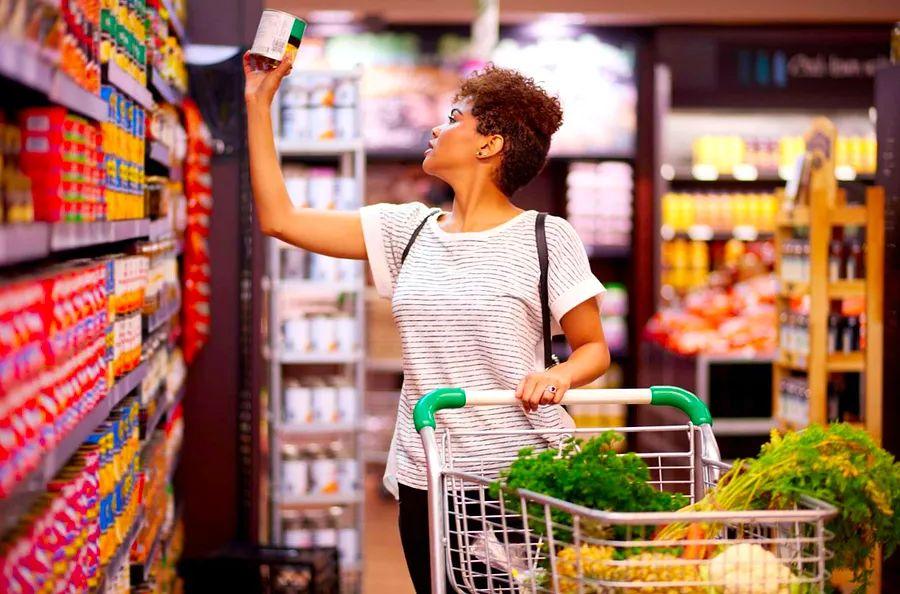Hoarding vs. Stockpiling: How to Calculate Your Family's Food Needs for Isolation

In the world we're living in now due to COVID-19, grocery shopping has taken on a whole new significance. Food consumption has increased considerably — with kids home from school and many of us working remotely, most, if not all, meals are being prepared in one place.
"We are in a culture where cooking three meals a day at home is not the norm, so this shift is catching people off guard. Many aren't equipped to suddenly handle three daily meals at home," says Kristin Gustashaw MS, RDN, clinical dietitian at Rush University Medical Center in Chicago.
Emergency preparedness guidelines typically recommend stocking up on enough food for two weeks in case a family member falls ill and needs to isolate. But how do you figure out exactly what that means for your family? And how do you avoid overstocking? We enlisted a nutritionist-turned-mathematician to break down the numbers.
Grains
Recommended serving: 4-6 portions per day
What this could look like for one person over two weeks:
- two loaves of bread
- one box rice
- one box pasta
- one box oatmeal
- one box dried cereal
"Remember, this is for just one individual," Gustashaw explains. "If you multiply that by seven, you're looking at 14 loaves of bread, which can feel overwhelming."
That's when she suggests focusing on variety. "Instead of 14 loaves of bread, think of it as four packs of English muffins, four bags of mini bagels, six tubes of biscuits or croissants, and three packs of tortillas. This is the same as 14 loaves of bread but with more variety, and it's much less intimidating to see in your shopping cart."
She adds, "From a nutritional standpoint, this also gives you more benefits, as different foods have different nutrient profiles." For pasta, consider various shapes, and mix in alternatives like quinoa, barley, bulgur, or polenta. For oatmeal, it can also be used in different recipes.
"Oatmeal is incredibly versatile; it can be used in cookies, meatloaf, and more. It doesn't have to be just a hot cereal," says Gustashaw.
Protein
Recommended serving: 4-6 ounces per day
What this could look like for one person over two weeks:
- one jar of nut butter
- two dozen eggs
- three cans of beans
- one can of chicken
- one pack of string cheese (12 per pack)
While meat can meet your protein needs, it may be harder to find at times, and it's also a good idea to diversify your protein sources. Just like with grains, varying your protein choices can make it less overwhelming when you look inside your fridge.
"Think outside the box when it comes to protein: Greek yogurt, protein powders, beans, nut butters, and cheese are all great options," suggests Gustashaw. She also recommends getting two to three cups of milk daily. "This can include soy or almond milk, as long as it's a high-protein option with at least eight grams per serving," she adds.
Explore More: 10 Tips for Safe Grocery Shopping During the Coronavirus Outbreak
Fruits/Vegetables
Suggested serving: 4-8 cups per day
What this could look like for one person over two weeks:
- three cans of fruits (5 cups)
- three cans of vegetables (5 cups)
- six bags of frozen fruit (4 servings per bag)
- six bags of frozen veggies (4 servings per bag)
- one bag of fresh fruit (apples, pears, or a bunch of bananas)
- one bag of raisins/dried fruit (10 servings per bag)
Canned foods often get a bad reputation, but Gustashaw points out that "studies show people who eat canned vegetables typically consume more overall than those who avoid them. This is because fresh produce often spoils before it's eaten, despite good intentions, leaving people with fewer veggies on their plates." She recommends eating fresh fruit before it goes bad, or freezing it for smoothies later.
Don’t Forget the Essentials…
Many of us have more time on our hands now, so Gustashaw suggests using it wisely: try new recipes, learn to cook from scratch, and establish healthier habits. Stock up on kitchen essentials like olive oil, canola oil, flour, yeast, sugar, baking powder, baking soda, pancake mix, and various seasonings to create your own meals.
Note: While everyone's dietary needs may vary depending on health or caloric requirements, these suggested amounts are based on general emergency preparedness for the average person per day.

What’s Going On with the Empty Supermarket Shelves?
It started with toilet paper, then the canned goods shelves began to look bare. Now, it seems like every aisle in the grocery store is stripped clean, no matter where you turn.
Indeed, during this unparalleled situation, these empty shelves have sparked a chain reaction: hoarding.
"The thing is, hoarding is a natural behavior in animals, we just haven’t witnessed it much in our society because, especially in America, we’ve never really faced widespread scarcity in our lifetimes," explains Stephanie D. Preston, PhD, psychology professor at the University of Michigan. She adds that taking more than necessary is an instinctive response to stressful circumstances.
"In our lab experiments, we induce different emotions — anxiety, happiness, or neutrality — and then offer participants a variety of products for free, telling them to take as many as they want. What we found is that those who were anxious took more, showing a clear link between uncertainty and hoarding," says Stephanie D. Preston, PhD.
However, it's important to remember that the extreme cases of hoarding you see on the news are rare exceptions, not the rule.
"These are outliers, not the typical behavior," she explains. "Most people are simply taking a little more than necessary because of anxiety, but they're not going overboard."
The good news is that supply will soon catch up with demand, and as people adjust to their increased food needs, the tendency to overstock will subside.
Read More: Amid Empty Shelves, Experts Say There’s Enough Food for Everyone

1

2

3

4

5
Evaluation :
5/5